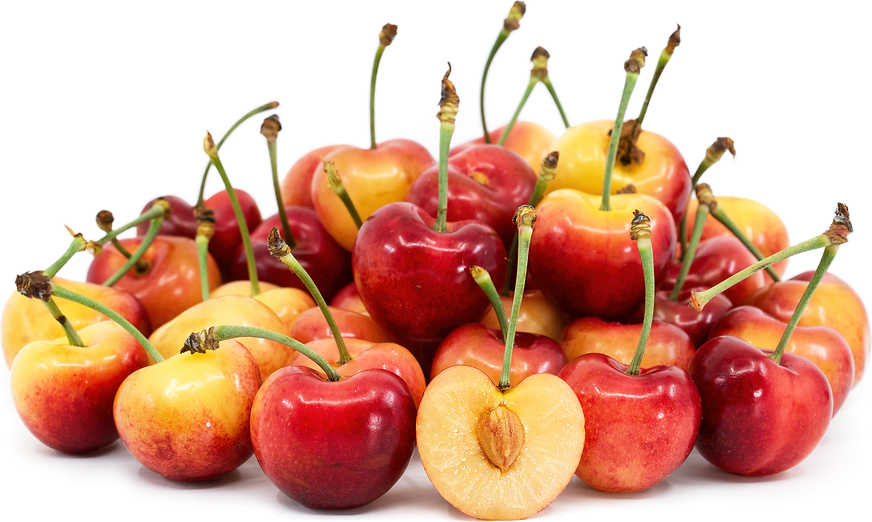


Rainier Cherries
Estimated Inventory, 18 lbs : 0
Description/Taste
Rainier cherries are a larger variety, averaging 2 to 3 centimeters in diameter, and have a round to heart-like shape with a dimple on the stem-end, attached to long and slender stems. The fruit’s skin is taut, glossy, smooth, and thin with a golden yellow base, covered in red, orange, and pink blush. Underneath the surface, the flesh is yellow to cream-colored, sometimes featuring red streaks near the seed, and has a semi-firm, plump, tender, and aqueous consistency, encasing a central light brown pit. Rainier cherries contain low acidity and have one of the highest sugar contents of sweet cherry varieties, ranging from 17 to 28 Brix. The fruits have a delicately floral, sweet flavor with notes of peaches and a caramel-like finish on the palate.
Seasons/Availability
Rainier cherries are available for a short season in the late spring through early summer.
Current Facts
Rainier cherries, botanically classified as Prunus avium ‘Rainier,’ is a sweet American hybrid variety belonging to the Rosaceae family. The golden yellow, red-blushed stone fruits grow on trees that can reach 9 to 10 meters in height and are climacteric in nature, meaning the cherries will continue to ripen off of the tree. Rainier cherries are considered a premium sweet cherry variety as they are only produced in limited quantities each season and are difficult to cultivate. The fruit’s skin is thin, easily bruised, and damaged, and a quarter to one-third of the crop is often destroyed by birds, leaving a small number of ripe fruits for domestic sale and international export. Rainier cherries were developed in Washington in the mid to late 20th century and were named after Mount Rainier, the tallest peak in Washington state. The variety is favored in commercial markets for its sweet taste and non-staining juice and is primarily consumed fresh as a snacking fruit. Rainier cherries are also a common home garden variety and are valued by cherry enthusiasts for the tree’s ornamental nature.
Nutritional Value
Rainier cherries are a good source of potassium to balance fluid levels within the body and fiber to regulate the digestive tract. The fruits also contain vitamins A and C to reduce inflammation, strengthen the immune system, and boost collagen production within the skin, and provide lower amounts of copper and manganese.
Applications
Rainier cherries have a sweet, floral flavor well suited for fresh preparations. The fruit’s juicy flesh can be consumed straight, out of hand, or it can be tossed into salads, used as a topping over pancakes and desserts, or stirred into acai bowls. Rainier cherries can also be blended into smoothies, juiced for cocktails, slushies, and sparkling beverages, used as a bite-sized appetizer on mini pie crusts, or integrated into ice cream and mousses. In addition to using the fresh fruits, the cherries can be simmered into jams, jellies, and preserves. Rainier cherries can also be used in baked applications, but their light-yellow coloring, juicy texture, and expensive price tag may not be suitable for all recipes. The fruits are occasionally incorporated into cakes, crumbles, cobblers, galettes, and tarts. Rainier cherries pair well with chocolate, vanilla, honey, other fruits such as peaches, nectarines, apricots, plums, and citrus, cinnamon, balsamic vinegar, and cheeses including robiola, ricotta, goat, and burrata. Whole, unwashed cherries will keep 5 to 7 days when stored in the coldest part of the refrigerator. The fruits can also be frozen for extended use.
Ethnic/Cultural Info
Rainier cherries are the only cherry variety to have their own national holiday in the United States. National Rainier Cherry Day is an annual event held on July 11th to recognize and celebrate the American-bred cherry. The holiday takes place in the height of cherry season, and farmer’s markets, growers, and supermarkets in the Pacific Northwest participate in festivals and outdoor gatherings to promote the sweet fruits. The Northwest Cherry Growers, a group working under the Washington State Fruit Commission, also selects one chef and restaurant in each of the fifty states to feature Rainier cherries on their menus over the national day. The cherry-filled event is a part of the Tree-to-Table program to highlight fruits directly sourced from farms, and the chefs that are chosen to highlight the cherries use the fruits in both sweet and savory preparations.
Geography/History
Rainier cherries were developed in 1952 by Harold Fogle of Washington State University's breeding program. Fogle was a part of the Irrigated Agriculture Research and Extension Center at the university and was initially assigned to breed peach trees. After a horrible winter freeze in 1949, causing the peach trees to die, Fogle was reassigned to develop a cherry that would be early-maturing, ripening before the popular bing cherry. Rainier cherries are a cross between the bing and van cherries, originally labeled as P 1-680 during research trials. The variety was officially recognized and selected for commercial cultivation in 1960. Today Rainier cherries are primarily grown in Washington state and throughout the Pacific Northwest, including Oregon. The fruits are also cultivated in California, Canada, and Chile and are sold domestically and exported to Asia. In Japan, Rainier cherries can average $1 to $5 per cherry. When in season, Rainier cherries are sold fresh through farmer's markets, supermarkets, and specialty distributors.

Recipe Ideas
Recipes that include Rainier Cherries. One
Podcast



